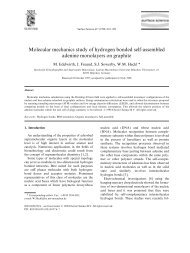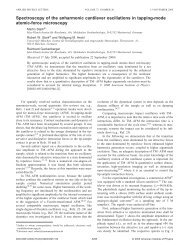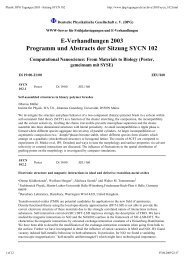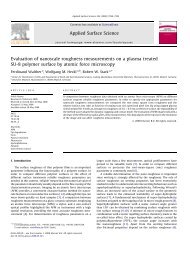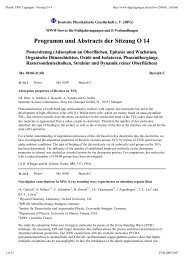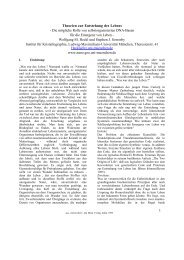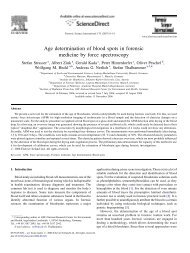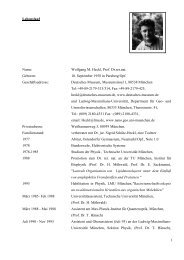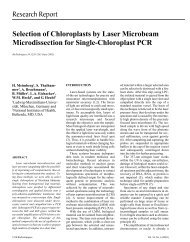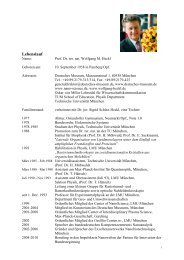Physik: DPG Tagungen - Sitzung O 28 - Nano-science.de
Physik: DPG Tagungen - Sitzung O 28 - Nano-science.de
Physik: DPG Tagungen - Sitzung O 28 - Nano-science.de
Create successful ePaper yourself
Turn your PDF publications into a flip-book with our unique Google optimized e-Paper software.
<strong>Physik</strong>: <strong>DPG</strong> <strong>Tagungen</strong> - <strong>Sitzung</strong> O <strong>28</strong><br />
http://www.dpg-tagungen.<strong>de</strong>/archive/2004/o_<strong>28</strong>.html<br />
[1] G. Henkelman and H. Jónsson, J. Chem. Phys. 113, 9978 (2000).<br />
[2] Ch. Ammon et al., Surf. Sci. 507, 845 (2002).<br />
O <strong>28</strong>.57 Poster Mi 16:00 Bereich C<br />
Electron Solvation during the Interaction of Na Atoms with Polar Molecules<br />
•A. Borodin 1 , O. Höfft 1 , U. Kahnert 1 , V. Kempter 1 , Y. Ferro 2 und A. Allouche 2<br />
1 Institut für <strong>Physik</strong> und <strong>Physik</strong>alische Technologien, TU Clausthal, Leibnizstr. 4, D-38678 Clausthal-Zellerfeld<br />
2 Physique <strong>de</strong>s Interactions Ioniques et Moléculaires, CNRS-UMR6633 Campus Universitaire <strong>de</strong> Saint Jérôme,<br />
Marseille France<br />
The interaction of Na atoms with molecular films (H 2 O; CH 3 OH; NH 3 ) was studied with metastable impact<br />
electron spectroscopy (MIES) un<strong>de</strong>r UHV conditions. The films were grown at 90K, and exposed to Na. The<br />
spectral feature from 3sNa ionization occurs at an energetic position different from that found for metals or<br />
semiconductors. The results are compared with DFT calculations. Experiment and theory agree in the energetic<br />
positions of the main spectral features from the molecular and sodium ionization. The calculations suggest that<br />
the 3sNa emission observed experimentally originates from solvated 3s electrons which are located far from the<br />
Na-core and become stabilized by solvent molecules. The simultaneous emergence of emission from OH (or<br />
CH 3 O) and from solvated 3s electrons suggests that the <strong>de</strong>localization and, consequently, the solvation play an<br />
important role in the Na-induced formation of CH 3 O and OH species from methanol and water, respectively.<br />
O <strong>28</strong>.58 Poster Mi 16:00 Bereich C<br />
Spectral evi<strong>de</strong>nce for oxi<strong>de</strong> free incorporation of oxygen into Ru(0001)<br />
•Raoul Blume 1 , Artur Böttcher 2 , Horst Conrad 3 und Horst Niehus 1<br />
1 Institut für <strong>Physik</strong>, HU-Berlin, Newtonstr. 15, 12489 Berlin<br />
2 Institut für <strong>Physik</strong>alische Chemie, Universität Karlsruhe, Kaiserstr. 12, 76131 Karlsruhe<br />
3 Fritz-Haber-Institut <strong>de</strong>r Max-Planck-Gesellschaft, Faradayweg 4-6, 14195 Berlin<br />
The capability of a smooth and <strong>de</strong>fected Ru(0001) surface towards the oxygen accumulation has been studied<br />
by the means of thermal <strong>de</strong>sorption spectroscopy (TDS) and the high resolution scanning XPS (Elettra,<br />
Trieste). By applying a soft Ar + -sputtering procedure individual surface <strong>de</strong>fects confined to the two outermost<br />
Ru layers were created. The oxidation procedure applied here assures an incorporation of oxygen atoms in the<br />
subsurface region up to 4 monolayer equivalents (MLE) without any traces of RuO 2 -domains (high-pressure<br />
and low-temperature surface oxidation). By measuring the temperature and exposure <strong>de</strong>pen<strong>de</strong>nce of the oxygen<br />
incorporation and analyzing the corresponding evolution of the Ru 3d 5/2 band we found characteristic electronic<br />
signatures allowing to distinguish oxygen atoms occupying the Ru(I)-Ru(II) interlayer space and oxygen species<br />
associated with surface <strong>de</strong>fects. This assignment is supported by mesoscopic-scale surface images as well as<br />
the quantitative O 2 -TD analysis.<br />
O <strong>28</strong>.59 Poster Mi 16:00 Bereich C<br />
Investigation of Au electro<strong>de</strong>position processes on metal single crystal surfaces<br />
•Ahmed Ayyad, Jochim Stettner und Olaf Magnussen<br />
Institut für Experimentelle und Angewandte <strong>Physik</strong>, Christian-Albrechts-Universität Kiel, Leibnizstraße 19,<br />
24098 Kiel<br />
Metal electro<strong>de</strong>position processes have been a subject of substantial basic research during the last years,<br />
motivated by current technologies as well as future applications, such as the electrochemical formation of<br />
ultrathin layers and nanostructures. A major, largely unsettled question is how the electro<strong>de</strong> surface structure<br />
21 of 32 07.06.2009 22:14



